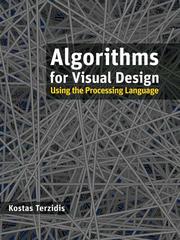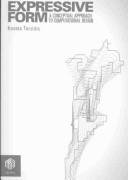| Listing 1 - 6 of 6 |
Sort by
|
Book
ISBN: 9781138136113 9780750667258 0750667257 9780080461298 9781136430022 9781136430060 9781136430077 Year: 2015 Publisher: Abingdon, Oxon ; New York, NY : Routledge,
Abstract | Keywords | Export | Availability | Bookmark
 Loading...
Loading...Choose an application
- Reference Manager
- EndNote
- RefWorks (Direct export to RefWorks)
Why does the word design owe its origin to Latin and not Greek roots? Where do the limits of the human mind lie? How does ambiguity enter the deterministic world of computation? Who was Parmenides and why is his philosophy still puzzling today? This unique volume challenges the reader to tackle all these complex questions and more. Algorithmic Architecture is not a typical theory-based architectural book; it is not a computer programming or language tutorial book either. It contains a series of provocative design projects, and yet it is not just a design or graphic art book per se. Following the tradition of architecture as a conglomeration of various design fields - engineering, theory, art, and recently, computation - the challenge of this book is to present a concept that, like architecture, is a unifying theme for many diverse disciplines. An algorithm is not only a step-by-step problem-solving procedure, a series of lines of computer codes or a mechanistic linguistic expression, but is also an ontological construct with deep philosophical, social, design, and artistic repercussions. Consequently, this book presents many, various and often seemingly disparate points of view that lead to the establishment of one common theme; algorithmic architecture.
Design architectural --- Réalité virtuelle en architecture --- Architectural design --- Algorithms --- Architecture --- Computer-aided design --- Algorithmes --- Data processing --- Mathematics --- Philosophy --- Conception assistée par ordinateur --- Informatique --- Mathématiques --- Philosophie --- 72.013 --- 72:681.3 --- Algoritmische architectuur --- Algotecture --- Architectuur ; geometrische proportie ; maat ; getal --- Architectuur ; ontwerptechnieken ; 21ste eeuw --- Architectuur & technologie ; 21ste eeuw --- Experimentele architectuurontwerpen --- CAD (Computer-aided design) --- Computer-assisted design --- Computer-aided engineering --- Design --- Structural design --- Algorism --- Algebra --- Arithmetic --- Architectuur ; proportie, symmetrie, harmonie --- Architectuur en computerwetenschappen --- Foundations --- Mathématique --- Informatique appliquée --- Image de synthèse --- Algorithmes. --- Réalité virtuelle en architecture. --- Conception assistée par ordinateur. --- Informatique. --- Mathématiques. --- Philosophie. --- Architectural design - Data processing --- Architectural design - Mathematics --- Architecture - Philosophy --- Réalité virtuelle en architecture --- Conception assistée par ordinateur --- Mathématiques.

ISBN: 1282137824 9786612137822 0470503181 9780470503188 9780470375488 0470375485 9780470375488 9781282137820 6612137827 Year: 2009 Publisher: Indianapolis Wiley
Abstract | Keywords | Export | Availability | Bookmark
 Loading...
Loading...Choose an application
- Reference Manager
- EndNote
- RefWorks (Direct export to RefWorks)
As the first book to share the necessary algorithms for creating code to experiment with design problems in the processing language, this book offers a series of generic procedures that can function as building blocks and encourages you to then use those building blocks to experiment, explore, and channel your thoughts, ideas, and principles into potential solutions. The book covers such topics as structured shapes, solid geometry, networking and databases, physical computing, image processing, graphic user interfaces, and more.
Processing (Computer program language) --- Computer algorithms. --- Algorithms --- Object-oriented programming languages --- Computer algorithms --- 681.3* / / / / / / / / / / / / / / / / / / / / / / / / / / / / --- 72.012 --- 72.012 Architectuur. Bouwkunst--?.012 --- Architectuur. Bouwkunst--?.012 --- Computer science
Book
ISBN: 9780415644495 9780415644501 Year: 2015 Publisher: London Routledge
Abstract | Keywords | Export | Availability | Bookmark
 Loading...
Loading...Choose an application
- Reference Manager
- EndNote
- RefWorks (Direct export to RefWorks)

ISBN: 0415317444 Year: 2003 Publisher: New York Spon Press
Abstract | Keywords | Export | Availability | Bookmark
 Loading...
Loading...Choose an application
- Reference Manager
- EndNote
- RefWorks (Direct export to RefWorks)
With the increase use of computers, architecture has found itself in the midst of a plethora of possible uses. The book offers some alternative directions, which combine theoretical inquiry with practical implementation. Notions of exaggeration, hybridization, kinesis, algorithmic design, fold and warp are examined from different points of view : historical, mathematical, philosophical or critical.
Architecture --- Architecture --- Architecture --- Computer-aided design --- Data processing --- Mathematics --- Philosophy
Book

ISBN: 9783764386887 3764386886 3034609698 9783034609692 Year: 2008 Publisher: Basel De Gruyter
Abstract | Keywords | Export | Availability | Bookmark
 Loading...
Loading...Choose an application
- Reference Manager
- EndNote
- RefWorks (Direct export to RefWorks)
Die Digitalisierung hat den Diskurs der Architektur verändert: Dieser ist mittlerweile von einer Fülle neuer Begriffe bestimmt, die bislang entweder keine oder doch andere Bedeutungen im Kontext der Architekturtheorie und des architektonischen Entwurfs hatten. Seine Begrifflichkeiten und Strategien werden zunehmend durch Einflüsse geprägt, die an der Schnittstelle zu wissenschaftlichen und kulturellen Vorstelllungen der modernen Informationstechnologie entstehen. Ziel der neuen Reihe Kontext Architektur ist es deshalb, eine kritische Auswahl jener Begriffe zur Debatte zu stellen, die im aktuellen Diskurs eine Rolle spielen. Als Vitruv den Architekten als "uomo universale" beschrieb, schuf er dessen Selbstverständnis als eines Generalisten, der eine komplexe Realität gestaltet. Der architektonische Begriff der Komplexität hielt allerdings mit der industriell-gesellschaftlichen Wirklichkeit nicht Schritt, er verflachte zu einer formalen Beliebigkeit. Die architektonische Moderne setzte dagegen die Vereinfachung "Less is More". Vor diesem Hintergrund führte Robert Venturi den Begriff in den Architekturdiskurs neu ein: Es ging dabei nicht nur um eine Wiedergewinnung der Komplexität der architektonischen Formen und ihrer Geschichte, sondern auch um das Eingehen auf das Vorgefundene als konkrete Realität. Heute prägt die Komplexitätsforschung, ausgehend von der Physik, den aktuellen Umgang mit dem Begriff der Komplexität. Sie hat eine neue Verbindung zwischen Naturwissenschaften und Informationstechnologie geknüpft und ist so zu einer zentralen Voraussetzung computerbasierter Entwurfskonzepte geworden. Digitalization has transformed the discourse of architecture: that discourse is now defined by a wealth of new terms and concepts that previously either had no meaning, or had different meanings, in the context of architectural theory and design. Its concepts and strategies are increasingly shaped by influences emerging at the intersection with scientific and cultural notions from modern information technology. The series Context Architecture seeks to take a critical selection of concepts that play a vital role in the current discourse and put them up for discussion. When Vitruvius described the architect as a "uomo universale," he gave rise to the architect's conception of him- or herself as a generalist who shapes a complex reality. The architectural concept of complexity, however, failed to keep pace with industrial and social reality, becoming instead an increasingly formal and superficial notion that could ultimately be applied to almost anything. Against it, architectural modernism set the watchword of simplification: "less is more." In this situation, Robert Venturi reintroduced the notion of complexity into architectural discourse: his goal was not just to restore the complexity of architectonic forms and their history but also to explore the concrete reality of the existing built environment. Today it is complexity studies, with their starting point in physics, that define the current approach to the concept of complexity. They have established a new connection between the natural sciences and information technology and have thus become a central premise of computer-based approaches to design.
Architecture --- Complexity (Philosophy) --- Complexité (Philosophie) --- Philosophy. --- Philosophie --- Complexité (Philosophie) --- Philosophy --- Emergence (Philosophy)
Book

ISBN: 303460971X Year: 2012 Publisher: Basel : Birkhäuser,
Abstract | Keywords | Export | Availability | Bookmark
 Loading...
Loading...Choose an application
- Reference Manager
- EndNote
- RefWorks (Direct export to RefWorks)
Die Digitalisierung hat den Diskurs der Architektur verändert: Dieser ist mittlerweile von einer Fülle neuer Begriffe bestimmt, die bislang entweder keine oder doch andere Bedeutungen im Kontext der Architekturtheorie und des architektonischen Entwurfs hatten. Seine Begrifflichkeiten und Strategien werden zunehmend durch Einflüsse geprägt, die an der Schnittstelle zu wissenschaftlichen und kulturellen Vorstelllungen der modernen Informationstechnologie entstehen. Ziel der neuen Reihe Kontext Architektur ist es deshalb, eine kritische Auswahl jener Begriffe zur Debatte zu stellen, die im aktuellen Diskurs eine Rolle spielen. Als Vitruv den Architekten als "uomo universale" beschrieb, schuf er dessen Selbstverständnis als eines Generalisten, der eine komplexe Realität gestaltet. Der architektonische Begriff der Komplexität hielt allerdings mit der industriell-gesellschaftlichen Wirklichkeit nicht Schritt, er verflachte zu einer formalen Beliebigkeit. Die architektonische Moderne setzte dagegen die Vereinfachung "Less is More". Vor diesem Hintergrund führte Robert Venturi den Begriff in den Architekturdiskurs neu ein: Es ging dabei nicht nur um eine Wiedergewinnung der Komplexität der architektonischen Formen und ihrer Geschichte, sondern auch um das Eingehen auf das Vorgefundene als konkrete Realität. Heute prägt die Komplexitätsforschung, ausgehend von der Physik, den aktuellen Umgang mit dem Begriff der Komplexität. Sie hat eine neue Verbindung zwischen Naturwissenschaften und Informationstechnologie geknüpft und ist so zu einer zentralen Voraussetzung computerbasierter Entwurfskonzepte geworden. Digitalization has transformed the discourse of architecture: that discourse is now defined by a wealth of new terms and concepts that previously either had no meaning, or had different meanings, in the context of architectural theory and design. Its concepts and strategies are increasingly shaped by influences emerging at the intersection with scientific and cultural notions from modern information technology. The series Context Architecture seeks to take a critical selection of concepts that play a vital role in the current discourse and put them up for discussion. When Vitruvius described the architect as a "uomo universale," he gave rise to the architect's conception of him- or herself as a generalist who shapes a complex reality. The architectural concept of complexity, however, failed to keep pace with industrial and social reality, becoming instead an increasingly formal and superficial notion that could ultimately be applied to almost anything. Against it, architectural modernism set the watchword of simplification: "less is more." In this situation, Robert Venturi reintroduced the notion of complexity into architectural discourse: his goal was not just to restore the complexity of architectonic forms and their history but also to explore the concrete reality of the existing built environment. Today it is complexity studies, with their starting point in physics, that define the current approach to the concept of complexity. They have established a new connection between the natural sciences and information technology and have thus become a central premise of computer-based approaches to design.
| Listing 1 - 6 of 6 |
Sort by
|

 Search
Search Feedback
Feedback About
About Help
Help News
News